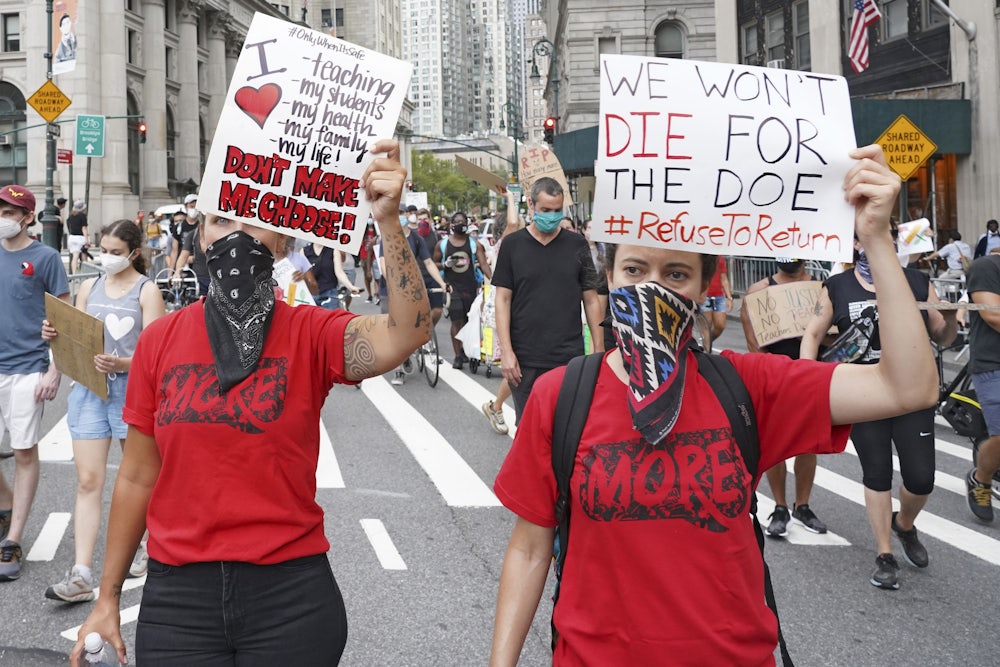What worries me most about schools reopening in the fall is that more people will die. Right now teachers are feeling like we’re rushing toward a reopening that isn’t well thought out. That’s why teachers across the country are talking about safety strikes and staging sick-outs. As I mentioned back in May, just among my students’ families and our paraprofessionals’ families in my small classroom, we had 14 deaths from Covid-19. I don’t want that happening again, and I know that my students are still dealing with that grief.
Under the current reopening plan at my school, we’re going to have three cohorts because we can only fit about a third of the students in the school under the social distancing guidelines in place. And that means that students are only going to be in school one to two days a week. But if I’m in the classroom on Monday and cohort A is with me, then cohort B and C are going to be home remote-learning. Who’s going to be teaching them that day? We just haven’t gotten any information or transparency on questions like that.
There’s also the issue of proper ventilation. So many of our school buildings are older or already overcrowded; they’re not set up for social distancing. My classroom is windowless, which means that it would need an HVAC filter. But my principal is worried that there won’t be an adequate filter set up by fall, so I’m going to have to teach my class in the library and share that space with another class that can’t use their classroom for safety reasons. So that’s at least two classrooms in the same library, with everyone trying to learn and simultaneously trying to socially distance from each other. How is that a good idea for students or for teachers?
For those arguing that it’s our duty to go back to school, like The Atlantic piece about teachers “rising to the occasion” of essential work, I’d tell them that our duty is to each other—to protect each other and to make sure the community is safe. And in a pandemic, we do that through making sure that we’re social distancing and staying away from indoor areas as much as we can.
The reason I am not going back to the classroom is to keep all of us safe. None of us should be martyrs, and making ourselves martyrs will only create resentment. It just doesn’t make sense to have an eighth of the city’s population—1.1 million students—go back to schools in person. That’s going to increase the spread of the coronavirus and put all New Yorkers in danger.
I think even before this crisis, every public school teacher in America already had to reckon with the idea of boundaries: What am I willing to do beyond my job description to educate our students? And every single teacher I know has constantly gone above and beyond the call of duty, whether that’s grading late into the night or buying books or school supplies or even food for students. I know teachers who have bought diapers for students’ families.
I have the utmost respect for nurses and doctors, grocery store and restaurant workers, and postal service workers—everyone who has been out there providing us with health care, getting us food, getting us our mail and our packages. I have the deepest condolences for the essential workers who have passed away from the coronavirus. And when people say that teachers are essential workers, too, and that schools should reopen, I think we have to unpack that idea a bit.
Schools do provide food for low-income students, temporary shelter for homeless students, and childcare for parents. But schools only have to be that support system in a broken society. Plenty of other countries provide childcare and things like parental leave and family leave for their workers. We’re the only country in the developed world that doesn’t have that for workers. Our lack of a social safety net means that schools and teachers became the default support network for so many kids.
Is it essential for me to teach my students and socialize with them in person during a pandemic where more than 150,000 people in the United States have already died? The answer is no, and doing that will only put students and their families, and teachers and our families, at risk.
To actually reopen safely this fall, New York schools would need a lot more funding. There is just no plan that is feasible right now given the budget cuts. My school’s whole budget has been slashed. We have no money at all this year for materials. And keep in mind that we already didn’t have enough soap in our school in early March; we had broken sinks in our students’ bathrooms. Last year I had to buy my own air purifier for my windowless classroom. Schools have been defunded for decades, and that’s led to crumbling infrastructure, even cockroaches and rats crawling around some people’s classrooms.
New York public schools’ central administration has said they’ll be covering personal protective equipment, cleaning supplies, temperature checks, and things like that in the fall. But at this point, not every school has a nurse. We don’t have enough counselors and social workers in every school to deal with the trauma that students and families have gone through as they’ve lost jobs or have lost relatives and friends to Covid-19.
Teachers right now are reckoning with the fact that our leadership—our government—doesn’t care about us. I’m scared that teachers are going to resign or retire or take unpaid leave in these conditions. They’re going to leave in droves. And we are going to have an educational crisis like no other because our leaders are telling us we don’t matter.
The choice New York teachers are going to have to make this fall is whether or not to call a work action in order to save other people’s lives—and our own.
